The Real Rencers
The Marsh Arabs
Ancient Times to Present
Located between the southern Iraqi cities of An Nasiriyah and Basra, lies the Al Hammar Marsh, a 1,100-square-mile freshwater sea of marshlands. Formerly Mesopotamia, families have lived in the area for thousands of years. The marshlands, also known as the Tigris-Euphrates alluvial salt marsh, had for some time been considered a refuge for elements persecuted by the Saddam government, and, in centuries past, refuges for escaped slaves and serfs. A complex ecosystem created by the annual flooding of the Euphrates and Tigris rivers, Iraq's marshes have sustained human civilization for more than 5,000 years. Some of the earliest settlements of Mesopotamia — "the land between the rivers" — were built on floating reed islands in these very wetlands. This was one of the first places where human beings developed agriculture, invented writing and worshiped a pantheon of deities. In more recent times, the remoteness of the region, the near-absence of roads, the difficult terrain and the indifference of Baghdad's governing authorities insulated the area from the political and military upheavals that buffeted much of the Arab world.
Culture
Traditionally, the society of the Marsh Arabs is split into two groups based on occupation. The group known as the Ma'dan breed and raise buffalo, while the majority cultivate crops such as rice, barley, wheat and millet and some sheep and cattle. More recently a third main occupation has entered 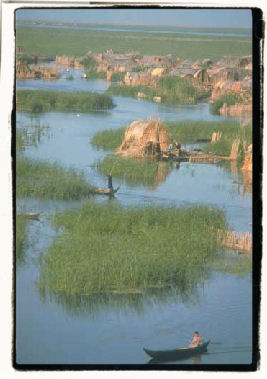 Marsh Arab life; the weaving of reeds on a commercial scale. Long used for personal use, reed mats have recently become a commercial commodity all across southern Iraq. Though often paying far more than the agriculture, weavers are looked down upon by both Ma'dan and farmers alike, though financial concerns mean that gradually it is gaining acceptance as a respectable profession. As with most tribes of southern Iraq, the sheik of a Marsh Arab group will collect a tribute from his tribesmen in order to maintain the mudhif, the tribal guesthouse which acts as the political, social, judicial and religious centre of Marsh Arabic life. The mudhif is used as a place to settle disputes, carry out diplomacy with other tribes and the gathering point for religious celebrations and prayer. It is also the place where visitors are offered hospitality. Most Marsh Arabs are Shi'a Muslims.
Marsh Arab life; the weaving of reeds on a commercial scale. Long used for personal use, reed mats have recently become a commercial commodity all across southern Iraq. Though often paying far more than the agriculture, weavers are looked down upon by both Ma'dan and farmers alike, though financial concerns mean that gradually it is gaining acceptance as a respectable profession. As with most tribes of southern Iraq, the sheik of a Marsh Arab group will collect a tribute from his tribesmen in order to maintain the mudhif, the tribal guesthouse which acts as the political, social, judicial and religious centre of Marsh Arabic life. The mudhif is used as a place to settle disputes, carry out diplomacy with other tribes and the gathering point for religious celebrations and prayer. It is also the place where visitors are offered hospitality. Most Marsh Arabs are Shi'a Muslims.
Devastation
After the First Gulf War in 1991, Saddam Hussein aggressively revived a program to divert the flow of the Tigris River and the Euphrates River away from the marshes in retribution for a failed Shia uprising. This was done primarily to eliminate the food source(s) of the Marsh Arabs. The plan also systematically converted the wetlands into a desert, forcing the Marsh Arabs out of their settlements in the region. Less than 5% of the marshes remain today.
A Rebuilding
After the overthrow of Saddam in April 2003, local people began breaching the dikes and dams and blocking the canals that had drained the wetlands. Ole Stokholm Jepsen, a Danish agronomist and senior adviser to the Iraqi Minister of Agriculture, says that 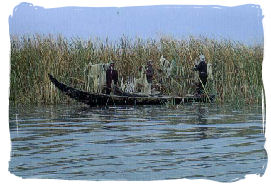 "recovery has happened far faster than we ever imagined"; at least half of the roughly 4,700 square miles of wetland has been reflooded. But that's not the end of the story. Fed by the annual snowmelt in the mountains of Anatolia, Turkey, the marshes were once among the world's most biologically diverse, supporting hundreds of varieties of fish, birds, mammals and plant life, including the ubiquitous Phragmites australis, or ordinary marsh reed, which locals use to make everything from houses to fishing nets. But Saddam's depredations, combined with ongoing dam projects in Turkey, Syria and northern Iraq, have interfered with the natural "pulsing" of floodwaters, complicating restorative processes. "Nature is healing itself," said Azzam Alwash, a Marsh Arab who immigrated to the United States, returned to Iraq in 2003 and runs the environmental group Nature Iraq, based in Baghdad. "But many forces are still working against it." Only a few thousand of the nearly half million original inhabitants remain. Most of the rest that can be accounted for are refugees living in other Shi'a areas in Iraq, or have emigrated to Iran.
"recovery has happened far faster than we ever imagined"; at least half of the roughly 4,700 square miles of wetland has been reflooded. But that's not the end of the story. Fed by the annual snowmelt in the mountains of Anatolia, Turkey, the marshes were once among the world's most biologically diverse, supporting hundreds of varieties of fish, birds, mammals and plant life, including the ubiquitous Phragmites australis, or ordinary marsh reed, which locals use to make everything from houses to fishing nets. But Saddam's depredations, combined with ongoing dam projects in Turkey, Syria and northern Iraq, have interfered with the natural "pulsing" of floodwaters, complicating restorative processes. "Nature is healing itself," said Azzam Alwash, a Marsh Arab who immigrated to the United States, returned to Iraq in 2003 and runs the environmental group Nature Iraq, based in Baghdad. "But many forces are still working against it." Only a few thousand of the nearly half million original inhabitants remain. Most of the rest that can be accounted for are refugees living in other Shi'a areas in Iraq, or have emigrated to Iran.
Another reality is that the marshes will almost certainly never recover completely. In earlier times, the Tigris and Euphrates, overflowing with snowmelt from the Turkish mountains, spilled over their banks with seasonal regularity. The floods flushed out the brackish water and rejuvenated the environment. "The timing of the flooding is vital to the health of the marshes," says Azzam Alwash. "You need fresh water flowing in when the fishes are spawning, the birds are migrating, the reeds are coming out of their winter dormancy. It creates a symphony of biodiversity."
Overcoming Troubled Times
In another village, Al Huwitha, men dressed in the traditional gray robes called dishdashas, women dressed in the traditional black veils and robes called abayas, the villagers are concerned with water (mai) for drinking; rashes develop from the tainted water of the marshes.
In the 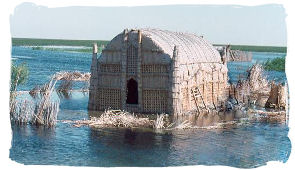 center of Al Huwitha rises a large mudhif, a 30-foot-high communal meetinghouse made entirely of reeds, with an elegant curving roof. The interior, which consists of a series of a dozen evenly spaced, cathedral-like arches, tightly woven from reeds, supporting a curved roof; oriental carpets blanket the floor. "We built the mudhif in 2003, following the old style," one of the men told me. "If you go back 4,000 years, you will find exactly the same design." Depicted: The present-day mudhif built as it has been for 4,000 years.
center of Al Huwitha rises a large mudhif, a 30-foot-high communal meetinghouse made entirely of reeds, with an elegant curving roof. The interior, which consists of a series of a dozen evenly spaced, cathedral-like arches, tightly woven from reeds, supporting a curved roof; oriental carpets blanket the floor. "We built the mudhif in 2003, following the old style," one of the men told me. "If you go back 4,000 years, you will find exactly the same design." Depicted: The present-day mudhif built as it has been for 4,000 years.
Al Huwitha's biggest problem stems from an unresolved tribal feud that goes back 15 years. The people of the village belong to a tribe that sheltered and fed the Shiite rebels just after the gulf war. In the summer of 1991, some 2,500 members of a rival tribe from Basra and wetlands to the north showed Saddam's Republican Guards where the Al Huwitha men were hiding. The Guards killed many of them, a British intelligence officer told me, and there's been bad blood between the two groups ever since. "Al Huwitha's men can't even move down the road toward Basra for fear of the enemy group," the officer went on. "Their women and children are allowed to pass to sell fish, buffalo cheese, and milk in Basra markets. But the men have been stuck in their village for years." In 2005, a furious battle between the two tribes erupted over a love affair — "a Romeo and Juliet story," the officer added. The fighting lasted for days, with both sides firing rocket-propelled grenades, mortars and heavy machine guns at each other. The officer asked the sheik of Al Huwitha "if there was any chance of a truce, and he said, 'This truce will happen only when one side or the other side is dead.'"
Most of the settlers, 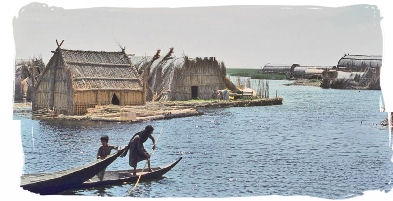 Marsh Arabs all, had abandoned their wetlands homes and were constructing squat, ugly houses out of concrete blocks and corrugated tin. The part of the marshes where they had lived is owned by sayeds, descendants of the prophet Muhammad, who forbade them from building "permanent structures," only traditional reed houses. This was unacceptable, and several hundred Marsh Arabs had picked up and moved to this bone-dry patch. It is a sign of the times: despite reconstruction of a few mudheefs, and some Marsh Arabs who say they would like to return to the old ways, the halcyon portrait of Marsh Arab life drawn by Wilfred Thesiger half a century ago has probably disappeared forever. A British officer had asked the settlers why they didn't want to live in reed huts and live off the land. "They all say they don't want it," the officer said. "They want sophistication. They want to join the world." Ole Stokholm Jepsen, the Danish agronomist advising the Iraqis, agreed. "We will have to accept that the Marsh Arabs want to live with modern facilities and do business. This is the reality."
Marsh Arabs all, had abandoned their wetlands homes and were constructing squat, ugly houses out of concrete blocks and corrugated tin. The part of the marshes where they had lived is owned by sayeds, descendants of the prophet Muhammad, who forbade them from building "permanent structures," only traditional reed houses. This was unacceptable, and several hundred Marsh Arabs had picked up and moved to this bone-dry patch. It is a sign of the times: despite reconstruction of a few mudheefs, and some Marsh Arabs who say they would like to return to the old ways, the halcyon portrait of Marsh Arab life drawn by Wilfred Thesiger half a century ago has probably disappeared forever. A British officer had asked the settlers why they didn't want to live in reed huts and live off the land. "They all say they don't want it," the officer said. "They want sophistication. They want to join the world." Ole Stokholm Jepsen, the Danish agronomist advising the Iraqis, agreed. "We will have to accept that the Marsh Arabs want to live with modern facilities and do business. This is the reality."
Though the plan would not exactly replicate the natural ebb and flow of floodwaters of a generation ago, "if we manage it well," Alwash says, "we can recover 75 percent of the marshes." He says that the Iraqi government will need between $75 million and $100 million to build the gates. "We can do this," he adds. "Bringing back the marshes is hugely symbolic, and the Iraqis recognize that."
Literature
The way of life of the Marsh Arabs was chronicled by Sir Wilfred Thesiger in his classic book The Marsh Arabs (1964). In his book, Thesiger describes a timeless environment of "stars reflected in dark water, the croaking of frogs, canoes coming home at evening, peace and continuity, the stillness of a world that never knew an engine." Thesiger lived with the Marsh Arabs for months at a time over a seven-year period (1951-1958), building excellent relationships with virtually all he met, and recording the details of day-to-day life in various regions of the marshes. Many of the areas that he visited have since been drained. Gavin Maxwell, the Scottish naturalist, travelled with Thesiger through the marshes in 1956 and published an account of their travels in his classic 1957 book A Reed Shaken by the Wind.
A Link to the Sumerians
Many academic authorities believe the Marsh Arabs to be the direct descendants of the Sumerians. It is also believed that their culture is highly reflective of their ancient ancestors. For example, children of the Marsh Arabs notably play with clay dolls identical to those of the Sumerians.
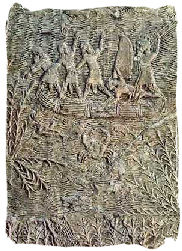 Depicted: Sennacherib, persuing Merodach-Baladan: "He fled like a bird to the swampland. I sent my warriors into the midst of the swamps … and they searched for five days'. But the King of Babylon could not be found. (703 BC)
Depicted: Sennacherib, persuing Merodach-Baladan: "He fled like a bird to the swampland. I sent my warriors into the midst of the swamps … and they searched for five days'. But the King of Babylon could not be found. (703 BC)
In 1968, archaeologists digging at the mound of al-Hiba in Iraq were struck by the fact that the people living in the surrounding area depended on many of the same resources, and seemed to use them in the same way, as the people who had lived there in the 3rd millennium BC. So while archaeological excavations continued, they initiated an ethnographic study of the modern villages around the mound . The ethnoarchaeology project was carried out under the direction of Edward Ochsenschlager and lasted twenty years. Its goal was to cast light on the use of locally available raw materials, and on the function and manufacturing technology of the same or similar artifacts in antiquity.The materials we focused on were mud or clay, reeds, wood, cattle, and sheep. There was abundant evidence that many of the details of village life had parallels in the archaeological record. The scientists hoped that knowing how people in the present day made and used the objects they needed for survival could help us make sense of the isolated bits of archaeological evidence and weave them into a coherent tapestry of ancient life.
The 2-mile-long mound of al-Hiba was in antiquity the ancient city-state of Lagash. It stood on the edge of a permanent marsh bordering a tributary of the Tigris, in southern Iraq, and lay about 75 kilometers north of Ur. Like Ur, Lagash was a major Sumerian city. It reached its greatest size in the Early Dynastic III period (2600-2350 BC), at the same time as the Royal Cemetery of Ur was in use. At that time Lagash was the capital of the Sumerian empire and probably the largest early Sumerian city.
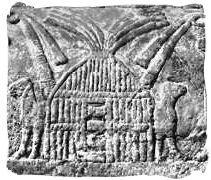 |
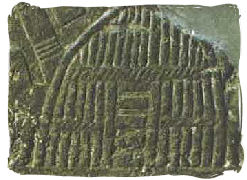 |
Arched reed houses and buildings of mud brick and pise are well attested in the archaeological record. The scientists concluded that in antiquity they were built in a very similar fashion to the way they have been built in modern times, in part because of the nature of the raw materials and in part because of direct evidence of manufacture from ancient strata. Some of the forms of sun-dried mud pottery are attested in Sumerian times by finds from al-Hiba. Preserved details of construction show that they were made in the same way as modern examples. Mud storage containers, jars, tanurs, ammunition for slings, and children's toys are widely known in antiquity from many sites. Ancient models of beds, perhaps made as toys, show the same raw materials used in the same fashion as the beds in modern courtyards. Impressions of ancient reed baskets and mats exhibit the same techniques of construction as do modern ones. Models of ancient boats show that they were very similar to modern ones and built of the same materials.
Even without corroborating evidence, some ancient parallels with modern functions can be assumed. Although the materials did not exist in antiquity, some modern aluminum, tin, plastic, and porcelain containers probably have generally the same functions as the pottery of antiquity. The physical requirements of animals would lead us to believe that ancient animal husbandry had much in common with the modern. In some cases, for instance in weaving, we can restore parts of the process and artifacts missing in the archaeological record.
Other details of life in Sumerian times can be inferred from ethnographic information. We can understand and better appreciate, for example, the degree of coordination and skill required for everyday activities in ancient times because both ancient and modem peoples used similar artifacts for similar purposes. Indeed, the physical and mental energy expended by young men in mastering the throw-net, spear, and sling is akin to effort put forth by first-class athletes today. Like modern Iraqi villagers who, at the age of eight or younger, have jobs which are important to the survival of their families, Sumerian children were probably productive members of their society. In modern Western society where we appear to think that work deprives children of their "childhood," and there is little work that children can profitably do, children tend to live, by contrast, an undemanding parasitic existence, often to rather advanced ages.
More speculative, perhaps, are such things as the role of individuals or groups of people. For instance, Iraqi villagers and ancient Sumerian craftsmen dealt in raw materials and artifacts which were crucial to the survival of the entire community (unlike many modern craftsmen who make decorative accessories and think of themselves as artists). It is possible therefore that the two Middle Eastern groups may have enjoyed similar respect and played similar roles in preserving traditional morality and work ethics.
Sadly, due to Saddam Hussein, the way of life that described in following, was obliterated. There are stragglers of Marsh Arabs attempting to rebuild and return to the life of their ancestors despite those that are pushing for a more modern lifestyle.
A Typical Village
The Ma'dan and the Beni Hassan
A number 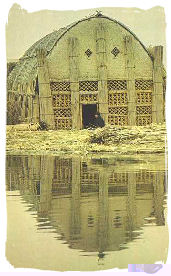 of small villages exist alongside the marshes, each containing the homes of either the Ma'dan (translated: "Marsh Arabs") (also, Mi'dan) or the Beni Hassan. Depicted: A modern reed house.
of small villages exist alongside the marshes, each containing the homes of either the Ma'dan (translated: "Marsh Arabs") (also, Mi'dan) or the Beni Hassan. Depicted: A modern reed house.
The Ma'dan villages are sometimes built directly in the marshes on platforms or islands they constructed of alternate layers of reed mats or reeds and silt. They make a living by fishing with spears and keep water buffalo, technically undomesticated, which forage for reeds and sedge in the marshes during the day and returned to the family shelter in late afternoon to give up their milk and spend the night under protection. The Ma'dan keep the water buffalo primarily for milk, dung, and hides. Of the three, dung is the most important for it provids fuel for warmth and cooking, and acts as a waterproofing agent, a plaster for wounds, and a cure for headaches.
The Beni Hassan keep sheep and cattle and graze them on the banks of the marsh. They raise crops of vegetables and animal fodder on plots of land which sometimes are irrigated. They also fish, but generally with throw nets.
Both tribes keep chickens, caught wild birds in nets or by shooting them with guns, and grow rice in small beds on the edges of the marshes. They move between settlements by donkey or camel, or in bitumen-covered wooden boats called tarada which are propelled through the water with long poles.
Mudhif And Raba
The Ma'dan and Beni Hassan build their houses and attendant structures from the same easily obtainable materials used to make similar buildings in ancient times — mud and reeds. 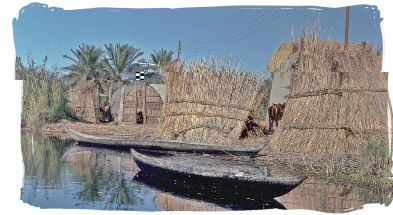 Reeds grow everywhere in the marshes and are considered the cheapest building material. Because of its size and architectural splendor, the mudhif, a grand arched structure built entirely of reeds by sheikhs, would dominate the horizon as one approaches a village lucky enough to preserve one. Justice is no longer dispensed here as it had been in the historical past, but issues are still debated and consensus reached on local issues by the heads of families with or without the sheikh being present. The mudhif also still serves as a guest house for the occasional traveler.
Reeds grow everywhere in the marshes and are considered the cheapest building material. Because of its size and architectural splendor, the mudhif, a grand arched structure built entirely of reeds by sheikhs, would dominate the horizon as one approaches a village lucky enough to preserve one. Justice is no longer dispensed here as it had been in the historical past, but issues are still debated and consensus reached on local issues by the heads of families with or without the sheikh being present. The mudhif also still serves as a guest house for the occasional traveler.
Except in the fortified compounds of major sheikhs (who buildwith baked bricks as well), mud-brick structures are very rare, for they require the services of professional builders and are quite expensive. Family members can build pise (compressed or packed mud) houses without any assistance, however, and a small number of these exist in every village, where they serve more as a status symbol indicating above-average material resources. The raba is an arched reed structure smaller than the mudhif. A one-room dwelling, called a bayt, is made of reeds, mud brick, or pise. 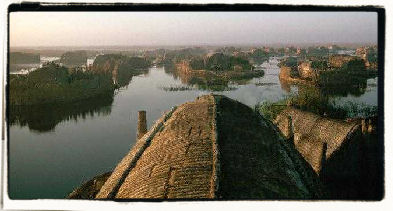 Most of the village houses are made of reeds. The typical house is usually a little more than 2 meters wide, about 6 meters long, and a little less than 3 meters high. Houses built of reeds have the additional advantage of being portable. In the spring, if the marsh waters rise too high, a five-arched raba could be taken down, moved to higher ground, and re-erected in less than a day. With proper care and repair, reed dwellings could last for well over 25 years, and mud dwellings for two or more generations.
Most of the village houses are made of reeds. The typical house is usually a little more than 2 meters wide, about 6 meters long, and a little less than 3 meters high. Houses built of reeds have the additional advantage of being portable. In the spring, if the marsh waters rise too high, a five-arched raba could be taken down, moved to higher ground, and re-erected in less than a day. With proper care and repair, reed dwellings could last for well over 25 years, and mud dwellings for two or more generations.
The raba had an entrance at both ends with a partition (bench or screen) in the middle. One end is used as a dwelling, the other end can be used to house animals in inclement weather, as a part of the dwelling, or as a workshop if either the wife or husband were craftspeople. In villages where no mudhif existed, the second room of the largest raba often served the same purposes: as a meeting place and guest house. None of these uses are mutually exclusive; a thorough cleaning followed by laying reed mats over the dirt floor and placing colorful carpets for people to sit on quickly converted a workshop or barn into a reception room.
Fences, Walls, and Barns
To protect the family's water buffalo during the inclement weather of late winter and early spring, a Ma'dan household will build an adjoining sitra, another type of reed structure. Rows of tall reeds are buried in the ground with their tops tied together to form a sort of roof. Holes or trenches are dug around the interior of the wall to keep the buffalo at bay and protect the comparatively fragile structure. These structures have a particularly shaggy appearance since neither the reed leaves nor plumed tops are removed. 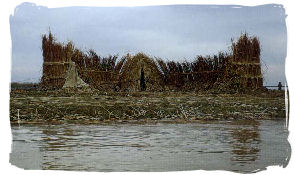 At the end of winter the sitra is often dismantled and used as fuel.
At the end of winter the sitra is often dismantled and used as fuel.
Livestock pens are generally built of tall reed fences and used by the Ma'dan for their water buffalo and sometimes by the Beni Hassan for their cattle and sheep. As such a fence is also called a sitra, it is not surprising to find that its method of construction is the same as for the building of that name. The sole difference is that the reed walls are left upright, perpendicular to the ground, rather than bent inward and joined to form a roof. Depicted: A sitra for water buffalo.
Most Beni Hassan make their walls of mud lumps or pise. When the structure is situated alongside a canal or irrigation channel, it is made of lumps of mud set on edge in herring-bone pattern; each lump consisting of a shovelful of mud, and its plano-convex shape, which results from the form of the shovel paddle, is almost identical to the shape of mud bricks used in ancient Sumerian times. Whenever possible, this is the kind of wall a villager prefers to build and maintain for it is much simpler and less time-consuming than erecting a wall of pise or reed.
Inside The Raba
Houses sre divided in two different ways. A reed mat tied to a reed frame could be fastened to the sides and top of one of the arches. If both rooms are intended for living, the partition had a doorway or opening. Such partitions, however, are most often used without doors for separating living space from animal quarters. Living spaces are usually subdivided by a wide bench made of a tied reed framework and reed bundle top which juts into the room from one of the long walls.
A chest made of wood, usually studded with iron or brass and with a domed lid, is placed on the women's or kitchen side of the bench. Towards the center of the women's side is a permanent place for the cooking fire. Mud bricks or narrow walls of pise supporting the vessels used for cooking or heating. The coffee pot (aluminum or brass) and tea kettle (aluminum) stands in close proximity, as does a variety of aluminum containers including a large, deep tray used for washing up and mixing, and one or two large bowls used for mixing, cooking, and sometimes serving. Conical bowls of various sizes made of aluminum, porcelain, or even plastic are also stored nearby. These were used for drinking water and for serving food. Those with bright, multicolored decorations, bought in market towns, are much sought after. To one side are the useful sundried mud objects made in every household. An aluminum or brass water jar stand near the door filled with water. 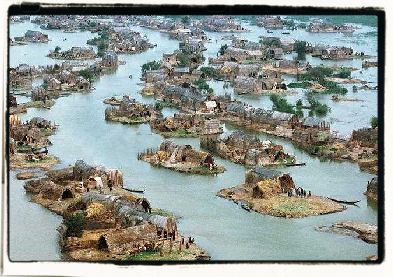 This is carried by members of the family as a toiletry and provides the water necessary for a thorough washing. If water is not available, one scrubs oneself with sand.
This is carried by members of the family as a toiletry and provides the water necessary for a thorough washing. If water is not available, one scrubs oneself with sand.
Also near the door are the baskets used for collecting fresh animal dung, a job allotted to the youngest girls in the family. Women mix the fresh dung with straw and mold it into disks to serve as the primary fuel for cooking and keeping warm. Along one side of the kitchen space is a shallow well dug in the floor and lined with bitumen in which sat two jars of similar shape and size: a water jar with drinking water and a jar for salt. These are made from coils of local clays by the village potter, and fired in a trench. Near the bench, or perhaps even under it, are homemade baskets (either plaited or coiled) with staples such as wheat, rice, or dried fish; a narrow-necked basket, called a sabat holds a variety of small packages of tea, coffee, and spices. The latter three items might also be kept in the chest along with clothes, raw wool or wool spun into thread or yarn by family members, special amulets, jewelry, and money. Some of these things are simply piled on the bench when not in use, as are woven bedclothes and pillows, carpets, paddles and poles for the boats used in the marshes, handmade fish and bird nets, agricultural or craft tools, and other family possessions.
The bench is seldom used as a sleeping platform at night except for the sick. Beds for small children are often made of piles of rushes with soft bedclothes on top. Swinging cradles for babies are made out of rushes and hung from an arch. A simple well is made in a bundle of rushes tied at both ends, and is lined with clothes, a sheepskin, or raw wool. Rattles made from sun-dried mud by fathers to amuse their babies are often inscribed with a simple smiling face, representing the child.
The other end of the raba is more sparsely furnished. When used exclusively as a part of the dwelling it contains a permanent hearth, otherwise a portable cooking dish, or manqala, is used as needed. Reed mats made by the women of the household cover the mud floor for living or guests. When guests are present, the mats are covered with carpets made by the village weaver and pillows made by one of the women of the household. Even in Ma'dan houses without provision for livestock, water buffalo share the quarters at special times, such as in the case of a birthing cow or a young calf whose mother had gone into the marshes to graze. When water buffalo or other livestock are quartered in the living space, the mats are removed. Oftentimes, the owner booby-traps both entrances to the raba at night to keep out intruders.
The Courtyard
Most 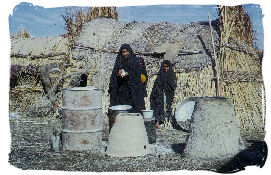 of the year, the courtyard outside the raba is a hive of activity. Women prepared most of the food here. They cook wheat bread disks on the insides of tanurs (mud beehive ovens) where the raw dough is pasted on with a bit of water or spit. Rice bread and small cakes were cooked on a flat disk of mud whose surface is heated in a fire. Meat and fish are baked or smoked in the tanur or boiled over a hearth and, on special occasions, roasted on spits over an open fire. Depicted: A raba courtyard.
of the year, the courtyard outside the raba is a hive of activity. Women prepared most of the food here. They cook wheat bread disks on the insides of tanurs (mud beehive ovens) where the raw dough is pasted on with a bit of water or spit. Rice bread and small cakes were cooked on a flat disk of mud whose surface is heated in a fire. Meat and fish are baked or smoked in the tanur or boiled over a hearth and, on special occasions, roasted on spits over an open fire. Depicted: A raba courtyard.
Reflections by Visitors to the Marsh Arabs
By Georges Roux, Ancient Iraq, 1964. Reprinted in 1992.
...the extensive marshes which cover the southern part of the Tigris-Euphrates delta also form a special district, widely different from the rest of Mesopotamia. With their myriads of shallow lakes, their narrow waterways winding through dense thickets of reeds, their fauna of water-buffalos, wild boars and wild birds, their mosquitos and their stifling heat, they constitute one of the most strange, forbidding and fascinating regions of the world. Although they may have varied in extent and configuration, anicient monuments and texts prove that they have always existed, and indeed, the Ma'dan, or marsh-Arabs, appear to have preserved to some extent the way of life of the early Sumerians established on the fringe of the swamps more than five thousand years ago.
From an archaeological point of view, the Iraqi marshes are still largely terra incognita. Reports from travellers suggest that traces of ancient settlements are exceedingly rare, probably because they consisted of reed-hut villages similar to those of today, which have completely disappeared or lie buried beneath several feet of mud and water. It is hoped, however, that modern methods – such as the use of helecopters – will eventually open to exploration a region which is by no means lacking in historical interest.
Gertrude Bell in a letter to her father dated 4th January, 1920
Now the Shamiyah was the garden of Mesopotamia, the pleasure ground, if you like. I had almost forgotten how lovely it is in winter. The willows and Euphrates poplars which edge the bank of river and canal are gold and golden green, and as a background forests of palms, all about 15 years old, i.e. at the most charming moment of their life before they become leggy. (It's curious to reflect that the palm acquires the physical peculiarities of a Backfisch with age.) It was dark when we reached our camp, which was pitched in open ground half way between the trees of two canals and about 2 miles from the river. Major Norbury is the most lavishly hospitable creature and the camp was luxurious – every comfort,
carpets, baths, oil-stoves, excellent meals. Next morning when I woke and stepped out of my tent into the bright sun and saw all the trees and things I wondered how anyone could live in Baghdad, or anywhere but the Shamiyah. Photo taken by Gertrude Bell.
But I must tell you the camp was pitched quite near the little village which is the headquarters of the principal shaikh of the district, Ibadi al Husain – I knew him before, of course. So after dinner he invited us to his mudhif, his guest house. Now a mudhif you can't picture till you've seen it. It's made of reeds, reed mats spread over reed bundles arching over and meeting at the top so that the whole is a huge, perfectly regular and exquisitely constructed yellow tunnel 50 yards long. In the middle is the coffee hearth, with great logs of willow burning. On either side of the hearth, against the reed walls of the mudhif, a row of brocade-covered cushions for us to sit on, the Arabs flanking us and the coffee-maker crouched over his pots. The whole lighted by the fire and a couple of small lamps, and the end of the mudhif fading away into a golden gloom. Glorious.
So there we sat and drank coffee and talked for an hour.
We spent next day in camp, Major N. and another man shooting – there's a mass of game – while Captain Mann and Wigan and I took horses from Ibadi and with the latter's brother rode down to the Hor, the marsh, half lake, into which all canals empty themselves. It's a rice country and they have had this year a bumper crop. The yellow reed villages lay fat and comfortable in the winter sun, banked up with rice straw. The great golden heaps of rice were not all housed or shipped away but lay on the harvest floors. Did I say glorious before? I'm afraid I did. When we reached the Hor we got into tiny sajahs, the local canoe-like boat, and rowed out by passageways through the reeds to the open water. There were thousands of duck and teal and other water birds. The osprey breeds here. The water was covered with the dying leaves of a small water lily on which buffaloes were peacefully browsing, standing belly-deep in the Hor. Of all incongruous diets for a buffalo, water lilies are certainly the most preposterous.
We rode home and lunched with Ibadi in his mudhif. The lunch wasn't ready till past 3 by which time we were hungry but we couldn't make so much as an impression on the mountains of food provided. All the tribe must have been fed that day from what was left. As a concession I was allowed a spoon for my rice – I do drop it about so. The others eat with their fingers.
From Encyclopaedia Britannica (1911 ed.)
The swamps are full of huge reeds, bordered with tamarisk jungles, and in its lower reaches, where the water stretches out into great marshes, the river is cloggedwith a growth of agrostis. To obtain a correct idea of this-region it must be borne in mind also that the course of the river and the features of the country on both banks are subject to constant fluctuation. The Hindieh canal and the main stream, the ancient Sura, rejoin one another at Samawa. Down to this point, the bed of the Euphrates being higher than that of the Tigris, the canals run from the former to the latter, but below this the situation is reversed.
At Nasrieh the Shattel-Hal, at one time the bed of the Tigris, and still navigable during the greater part vf the year, joins the Euphrates. From this point downward, and to some extent above this as far as Samawa, the river forms a seccession of weedy lagoons of the most hopeless character, the Paludes Chaldaici of antiquity, el Batihlt of the Arabs. Along this part of its course the river is apt to be choked with reeds and, except where bordered by lines of palm trees, the channel loses itself in lakes and swamps.
The inhabitants of this region are wild and inhospitable and utterly beyond the control of the Turkish authorities, and navigation of the river between Korna and Suk-esh-Sheiukh is unsafe owing to the attacks of armed pirates.
Sources
- Life on the Edge of the Marshes Edward Ochsenschlager, "Expedition," 1998, Vol. 40 Issue 2, p29, 11p
- Encyclopaedia Britannica © 1911, 2006.
- Smithsonian Magazine "Return to the Marsh" by Joshua Hammer, 2006
![]()
Disclaimer
These pages are not written for any specific home, but rather as informational pages for those not able to get ahold of the books and read them yourself. Opinions and commentaries are strictly my own personal views, therefore, if you don't like what you are reading — then don't. The information in these pages is realistic to what is found within the books. Many sites have added information, assuming the existences of certain products and practices, such as willowbark and agrimony for healing, and travel to earth and back for the collection of goods. I've explored the books, the flora, the fauna, and the beasts, and have compiled from those mentioned, the probabilities of certain practices, and what vegetation mentioned in the books is suitable for healing purposes, as well as given practicalities to other sorts of roleplaying assumptions.